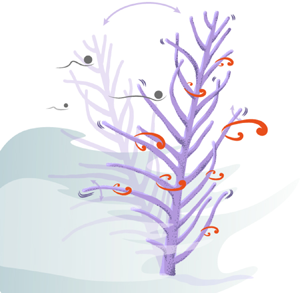Article contents
Vortex-induced vibrations: a soft coral feeding strategy?
Published online by Cambridge University Press: 14 April 2021
Abstract

Soft corals, such as the bipinnate sea plume Antillogorgia bipinnata, are colony building animals that feed by catching food particles brought by currents. Because of their flexible skeleton, they bend and sway back and forth with the wave swell. In addition to this low-frequency sway of the whole colony, branches of A. bipinnata vibrate at high frequency with small amplitude and transverse to the flow as the wave flow speed peaks. In this paper, we investigate the origin of these yet unexplained vibrations and consider their effect on soft corals. Estimation of dynamical variables along with finite element implementation of the wake-oscillator model favour vortex-induced vibrations (VIVs) as the most probable origin of the observed rapid dynamics. To assess the impact of the dynamics on filter feeding, we simulated particles advected by the flow around a circular cylinder and calculated the capture rate with an in-house monolithic fluid–structure interaction (FSI) finite element solver and Python code. We observe that vibrating cylinders can capture up to 40 % more particles than fixed cylinders at frequency lock-in. Therefore, VIVs plausibly offer soft corals a better food capture.
Information
- Type
- JFM Papers
- Information
- Copyright
- © The Author(s), 2021. Published by Cambridge University Press
References
REFERENCES
- 8
- Cited by


